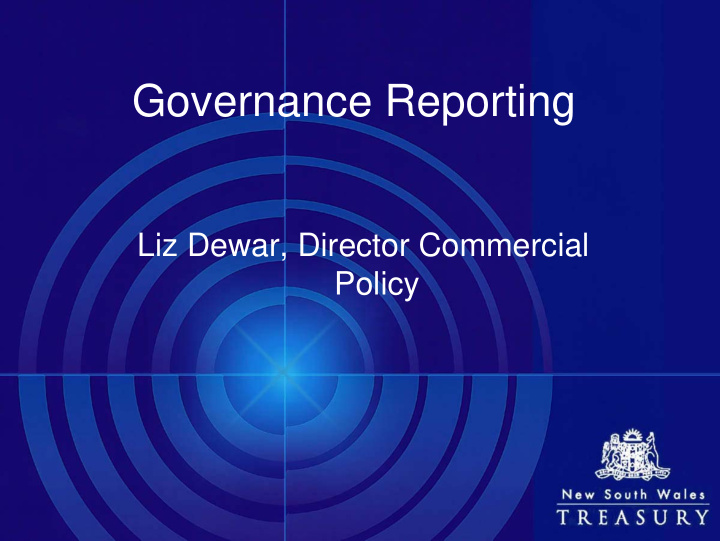



Governance Reporting Liz Dewar, Director Commercial Policy 1
Overview Government businesses Governance model in NSW � Shareholder model � commercial policy framework Governance reporting principles � ASX � OECD 2
Structure of State Sector STATE SECTOR PUBLIC FINANCIAL ENTERPRISES Treasury Corporation PUBLIC TRADING GENERAL GOVT GENERAL GOVT PUBLIC TRADING ENTERPRISES AGENCIES AGENCIES ENTERPRISES Non-Budget Non-commercial Commercial Budget dependent dependent E.g. E.g. - Department of Housing - Forests NSW E.g. E.g. - Department of - Minister Administering the - City West Housing - Zoological Parks Board Education and Training Environmental Planning and Assessment Act - Sydney Catchment - Department of Health -Public Transport Ticketing Corporation Authority - Western Sydney - Roads and Traffic Parklands - Sydney Water -Rail Infrastructure Authority SOCs Corporation - Growth Centres - Transgrid Commission -Rail Corporation of NSW - Adult Migration Service -EnergyAustralia (business unit in Education) GOVT BUSINESSES -Registry of Births Deaths and Marriages - Delta Electricity -Transport Infrastructure -State Property Authority -Macquarie Generation Development Corporation 3
Resources employed Capital expenditure of $8.5 billion 2008-09 � $36.4 billion over the forward estimates Total assets of over $110 billion Revenue of $13 billion Key Sectors � Transport � Electricity � Water Importance of governance framework 4
Corporate Governance Governance is about the relationships between management, board, shareholders and stakeholders provides the structure through which objectives are set and achieved. 5
Shareholder Model – State Owned Corporations Act 1989 Voting Treasury: Shareholder Shareholder Representative Portfolio Minister Board: •Independent CEO •Skills based Audit Committee 6
Commercial Policy Framework Aims To replicate private sector disciplines Promote efficient commercial practices Ensure SOCs are competitively neutral Rigorous and independent assessment 7
Commercial Policy Framework Policies and Guidelines Financial Distributions Capital Structure Guidelines for Boards of Treasury Management Government Businesses Projects of State Significance CEO Contract Guidelines Board appointment guidelines Reporting and Monitoring Policy for Government Indemnity businesses Government Guarantee Fee Corporate manual � SCI/SBI Guidelines Social Program Financial Appraisal Tax Equivalents 8
ASX Corporate Governance Principles Lay solid foundations for management and oversight Structure the Board to add value Promote ethical and responsible decision making Safeguard integrity in financial reporting Make timely and balanced disclosure Respect the rights of shareholders Recognise and manage risk Remunerate fairly and responsibly ‘if not why not’ approach to reporting 9
Guidelines for Boards of government businesses Majority of independent Board charter directors Code of conduct Disclosure of interests, benefits Risk management and internal or conflicts controls Maximum number of Board committees - audit and Directorships risk; HR and remuneration Directors – sufficient Independent Chair information, induction and continuing education Separation of Chair and CEO Regular performance evaluation Functions of Board disclosed 10
Annual report disclosure Disclosures by Boards � If recommendations in Guidelines not followed Annual Reports – legislative requirements � directors details � terms of appointment terms � attendance at meetings � remuneration and other benefits 11
Best practice OECD Principles Ensure an effective legal and regulatory framework The state should be an informed and active owner Equitable treatment of shareholders Relations with stakeholders Transparency and disclosure Responsibilities of the Boards Source: OECD Guidelines on Corporate Governance of State-owned enterprises, OECD 2005 12
Summary Reporting is a key element of good corporate governance, not a mere compliance exercise. Reporting allows regular monitoring and assessment of business performance. Good corporate governance does not mean reporting ‘once a year’ – materially significant information should be communicated as and when the need arises. 13
References OECD Principles of Corporate Governance 2004 www.oecd.org/document/49/0,3343,en_2649_34813_31530865_1_1_1_1,00.html OECD Guidelines on Corporate Governance of State- owned Enterprises 2005 www.oecd.org/LongAbstract/0,3425,en_2649_201185_34803225_1_1_1_1,00.html OECD Corporate Governance of State-Owned Enterprises: A Survey of OECD Countries 2005 www.oecd.org/document/22/0,3343,en_2649_34847_37441942_1_1_1_1,00.html Australian Securities Exchange Corporate Governance Council ‘Corporate Governance Principles and Recommendations’. Second Edition 2007 http://asx.ice4.interactiveinvestor.com.au/ASX0701/Corporate%20Governanc e%20Principles/EN/body.aspx?z=1&p=-1&v=1&uid= NSW Treasury Website www.treasury.nsw.gov.au 14 www.treasury.nsw.gov.au/pubs_by_pol#commercial
Recommend
More recommend